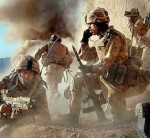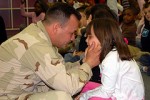I’m pleased to report momentum is building toward using The Warriors Guide to Insanity throughout the VA Health Care System as a counseling tool for helping Combat Veterans effectively deal with their PTSD challenges. It’s proving to be a great Mentoring tool also.
One Vet Center has been using the book for almost a year now and is reporting it’s one of the most effective tools available to help Combat Veterans. Not only because it was written by an actual Combat Veteran, but because it’s written in everyday Combat Warrior language they don’t need a dictionary to understand.
I’ve talked to approximately 70 Vets Centers who have purchased the book so far about how best to use the book in their practice as some are seeing the book for the first time. I share that the best model I’ve seen for using the book was developed by Guy McCommon ( MSW,LICSW ) at the Las Cruces Vet Center in New Mexico. He’s been kind enough to share his approach which I’ve inserted below. I hope you find it helpful…
From:
Guy M. McCommon, MSW, LICSW Team Leader, Las Cruces Vet Center Las Cruces, New Mexico 88001Phone: 575-523-9826 Email: guy.mccommon@va.gov
Using “The Warriors Guide to Insanity” as a tool for therapy is not rocket science. I have been using this book as a therapy tool for approximately 1 year and have found it to be one of the most effective tools available to help combat Veterans.
The book helps develop personal insight into how Veterans have been negatively affected by their war experience and how they can deal with it in positive ways to make changes in their lives. It develops a way to enhance self-esteem. Most of the Veterans I have had the opportunity to work with, in using this tool, have shared with me they find that they can understand what Sgt. Brandi is saying to them in the book and thus they benefit immensely.
The way it is written, they do not need a dictionary beside them when reading it to look up words.
When I share the book with a Veteran, I tell them, “This book is not written in clinical terms and that at times it does get a little rough”. The first approach, depending on the individual and where I determine they are in dealing with their PTSD issues, is to read the book chapter by chapter. Then we discuss how they feel they have been impacted by each chapter’s topic.
We then explore the correlation between the chapter’s topic and how they feel about the same issue they face, or how they have been affected and how they are dealing with it at this time. The main point, is for the Veteran to develop an understanding that they have been effected and have the resources and the personal power to deal with the negative impact that war has had on them and in their lives.
It is important the Veteran admits the ways they have been dealing with issues has not been helping them. Some individuals need to go over this repeatedly and others are able to comprehend it rapidly.
One of the most important things that it is necessary for the Veteran to understand is that they are the catalyst for change and growth in their lives and they have to do the work to make that change occur.
The Veteran needs to accept that they are capable of change and no one else is going to do it for them. They must be willing to make the efforts to help themselves get healthier, and use the tools and skills they have been introduced to. They must also accept that repetition is one of the most important aspects of success in this process, especially in internalizing the coping skills and tools.
The second approach is to have the Veteran read the entire book and then come back and discuss the insights gained; what they have learned about how PTSD has affected their lives and if they really want to make changes. I then have the Veteran outline what coping skills and tools they have learned from the book to make changes in their lives and how they are going to use them.
It is important that they look at how they deal with things now and that these ways of doing things have not been working for them. This approach is used for a Veteran who is more intellectually capable and who has the ability to process things more on their own. It is also necessary to have this individual realize the importance of repetition and self-esteem enhancement for success.
The most important aspect of using this tool, or any other tool, is to first gain and build the Trust Bond with the Veteran. Then help them realize they are capable of making change. And that change, although scary, will improve the quality of their lives and the lives of their families.












